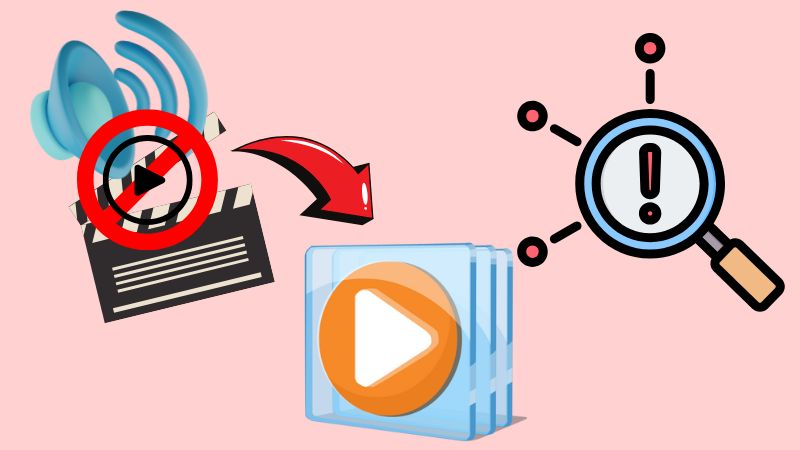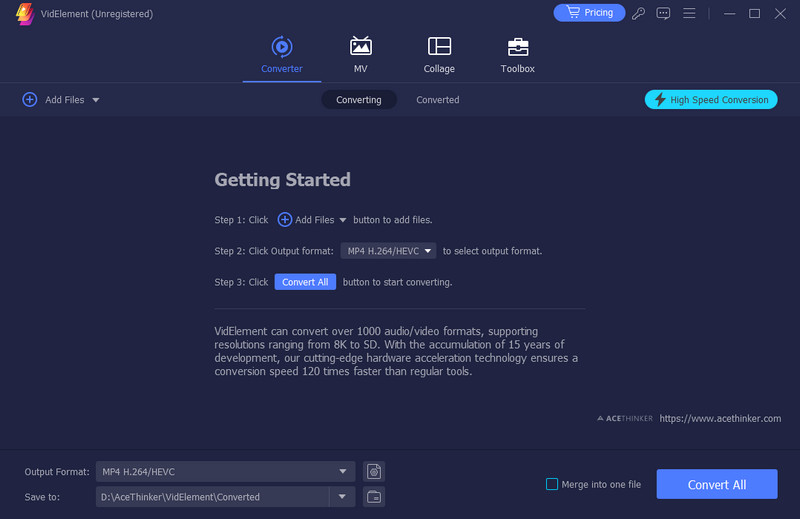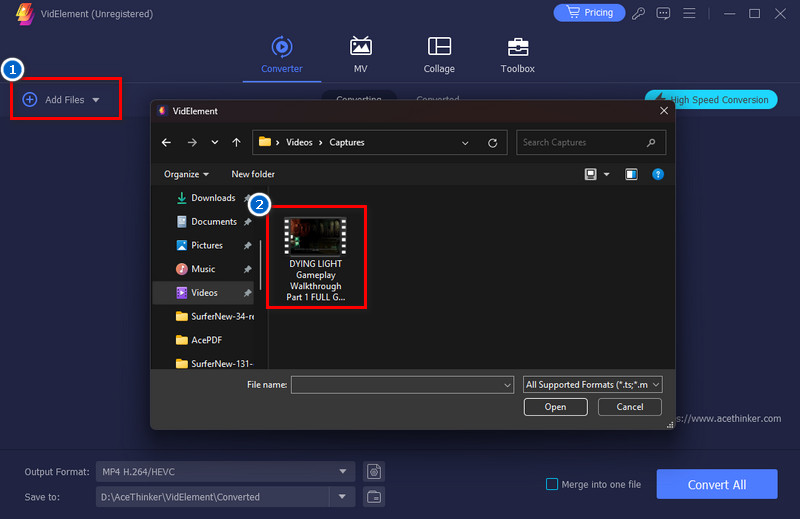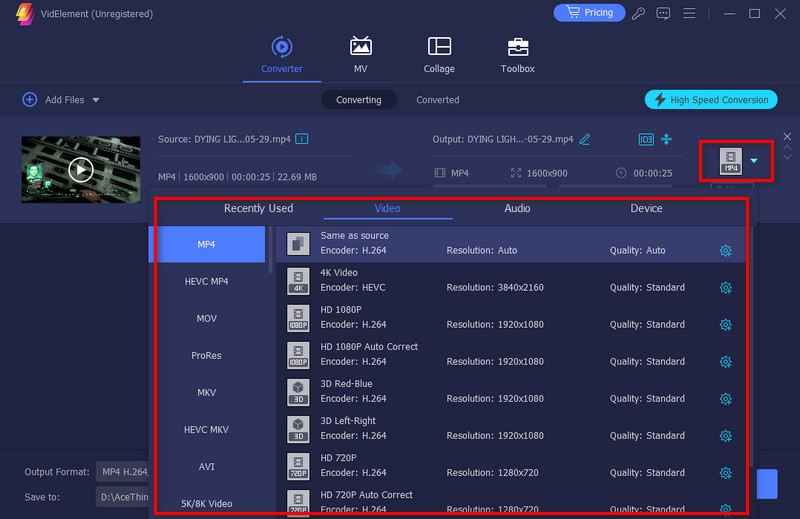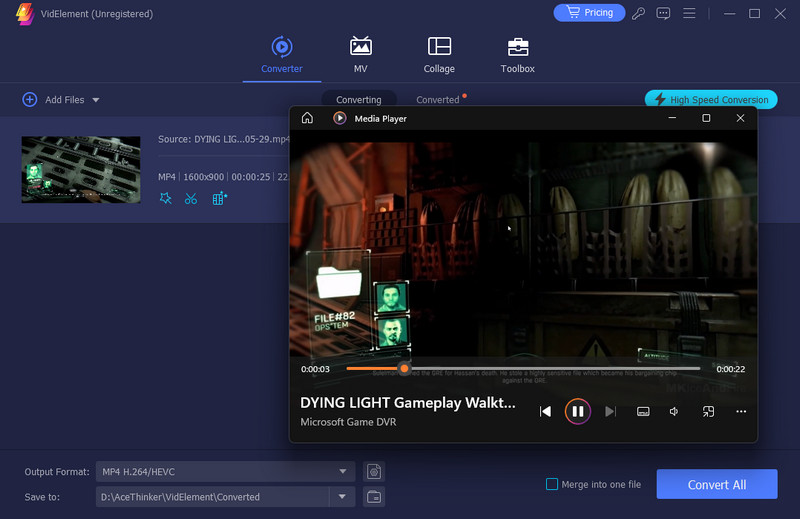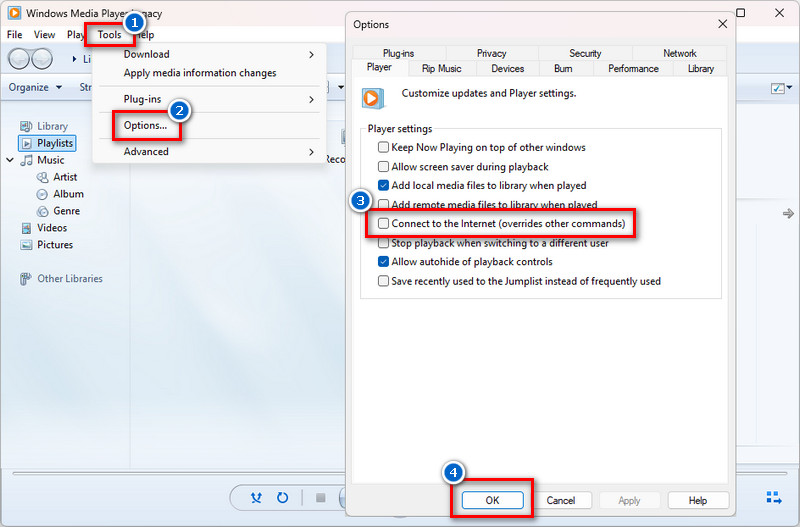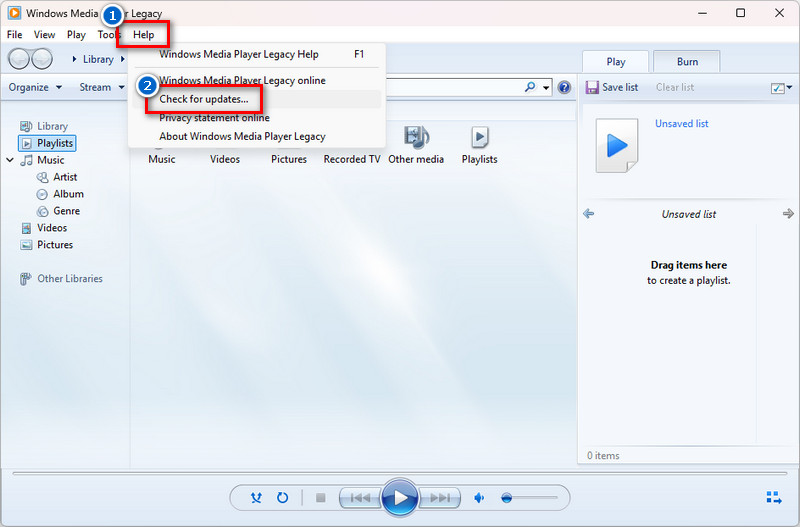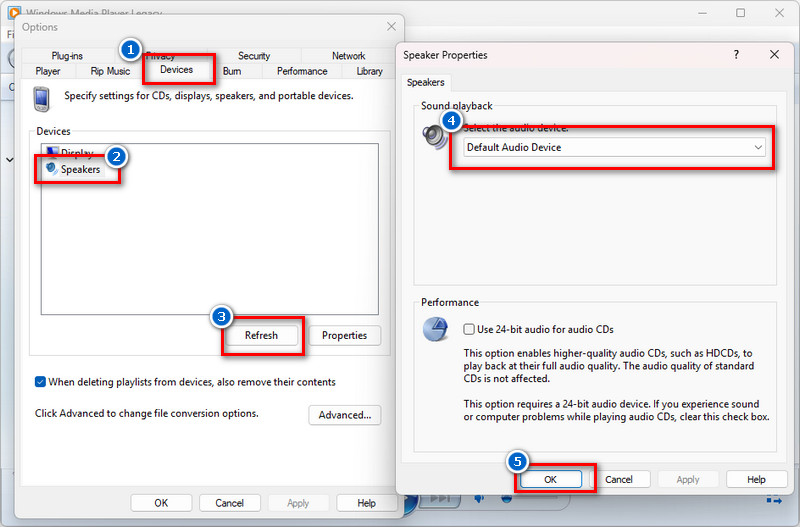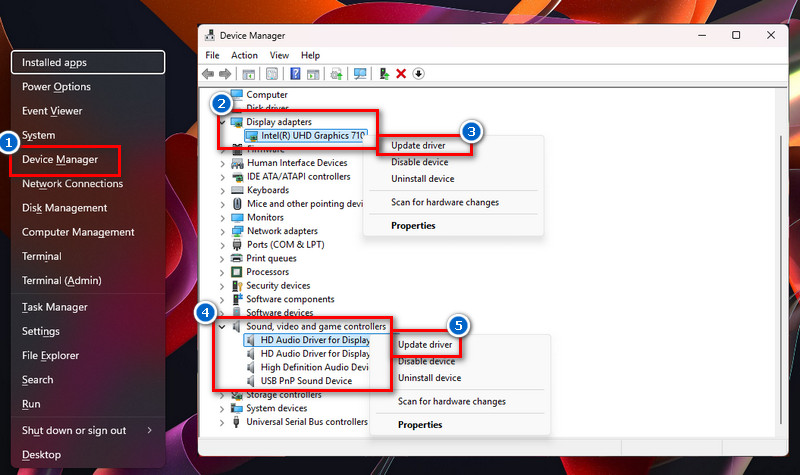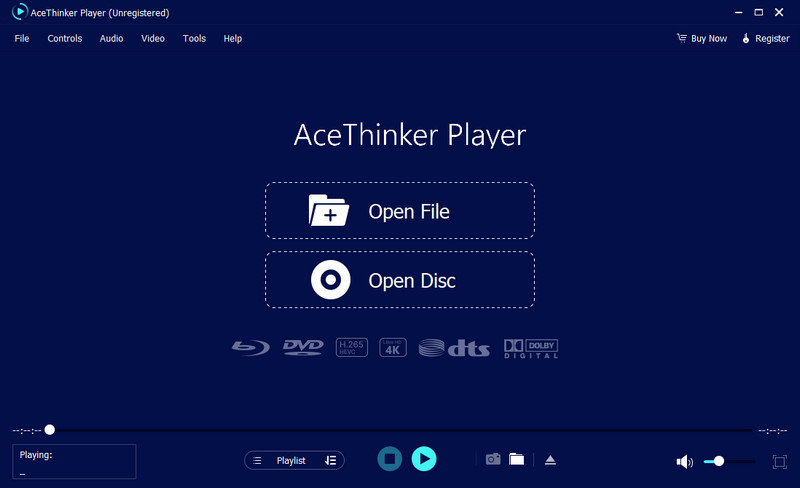
Error Codes of Windows Media Player
When Windows Media Player (WMP) encounters an issue, it may display an error code along with a message. These codes help identify the cause of video playback errors and Windows Media Player problems. Below are some common error codes and their meanings:
| Error Codes | Meaning | Causes |
|---|---|---|
| 0xC00D1199 | Windows Media Player cannot play the file | Unsupported file format or a corrupted file |
| 0xC00D11B1 | Windows Media Player encountered a problem while playing the file | Network issues, outdated drivers, or file corruption |
| 0xC00D10D1 | A codec is missing or not supported | Missing codecs required to play the file |
| 0x80040265 | Windows Media Player cannot open the file | The file is located in a restricted folder or is being used by another program |
| 0xC00D36C4 | Cannot play this file on your device | Unsupported format or DRM protection |
Why Do These Error Messages Appear?
Suppose you see the message "Windows Media encountered a problem while playing the file" while trying to play a video or audio file. In that case, it means something is preventing the file from opening. There are several possible reasons for this Windows Media Player problem. Below are some common causes and how they affect video playback.
1. Missing Codecs
Codecs are small programs that help Windows Media Player understand different file formats. If a file needs a codec that is not installed, the player cannot open it. This often happens with less common video or audio formats.
2. Unsupported File Formats
Windows Media Player may not support certain file types, such as MKV or FLAC. If the format is not compatible, the video will not play.
3. Damaged Video Files
The player cannot read a video file if it is incomplete or corrupted. This can happen due to incomplete downloads, bad storage devices, or file transfer errors.
4. Video Playback Errors Due to System Issues
Sometimes, problems with your computer, like outdated drivers or system errors, can cause playback issues. A simple restart or update may help.
By understanding these issues, you can take the right steps to fix them and enjoy smooth video playback.
The Windows Media Player (WMP) error that prevents you to play videos in the app usually occurs due to unsupported video codecs.
Although, there may be other reasons as well, such as incomplete download/ transfer of video file, virus infection or video corruption.
Working Solutions to Fix Windows Player Cannot Play The File
If you rely on Windows Media Player to play your media files and often encounter playback issues, you might need troubleshooting strategies. So, we listed some possible solutions that will help you get back to enjoying your media without interruption. Let’s have a look!
| Solution # | Solution Description | Success Rate |
|---|---|---|
| #1 | Check if the Media Player Supports the Video Format - Convert | 90% |
| #2 | Install Necessary Codecs | 75% |
| #3 | Update or Reinstall Windows Media Player | 65% |
| #4 | Wrong Audio Device | 50% |
| #5 | Switch to Another Media Player to Play Your Video Files | 99% |
Solution #1. Check if the Media Player Supports the Video Format
We all know that not all media file formats are supported by Windows Media Player. This incompatibility is a common cause of playback problems. So, to see if WMP supports video file formats, we listed its supported formats.
- Windows Media Formats: .asf, .asx, .avi, .wav, .wmv,.wax, .wma, .wm
- MPEG Formats: .mpeg, .mpg, .m1v, .mp2, .mp3, .mpa, .mpe, .m3u
- Apple QuickTime: .mov, .qt
- Audio Interchange File Format: .aif, .aiff, .aifc
If your file type is not among the listed formats, you will have to convert the file to a compatible format. We recommend that AceThinker VidElement convert videos to make them compatible with Windows Media Player. The program supports many file types, including MP4, MOV, MKV, AVI, WMV, and FLV. Also, the conversion process is quick and preserves the original quality. Additionally, if you have many media files that do not work on WMP, you can use its batch conversion. However, VidElement is a paid program, so expect that not all features are unlocked in the trial version.
Try it for Free
How to Convert Media Files Using VidElement
Step 1 Install the Video Converter
Click the download button above to get the VidElement installer package. Then, run the file and follow the installation wizard prompts to successfully install the program. After installation, the tool will automatically launch on your computer screen.Step 2 Import the Video File
To upload the media file, click the “* Add Files” button at the top left corner. A window containing your files will appear, allowing you to choose the file you want to upload. Alternatively, you can drag the video file and drop it into the interface.Step 3 Start Conversion Process
On the right side, click the dropdown icon beside MP4 to reveal the output formats available. Next, select the output format that Windows Media Player supports. Then, click on “Convert All” to start the process.Step 4 Play the Converted File
Once finished, a folder containing the converted file will automatically open. Right-click on the video and select the “Open With” option. Then, choose Windows Media Player to play the file on your PC.Solution #2. Install Necessary Codecs
Another way to fix Windows Media Player cannot play the file error is by installing the necessary codecs. Codecs are essential because they allow our computer to decode and encode video and audio files. So, suppose you encountered error code 0xC00D10D1 when you tried to play AVI files on Windows Media Player. In that case, it means that the required video codec is missing. In this case, you can install the K-Lite Codec Pack, a compilation of codecs. This pack enables WMP to play almost all video and audio file formats.
Here's how you install the K-Lite Codec Pack.
- First, download the K-Lite Codec Pack from its official website or a trusted source. Then, run the installer file and follow the setup instructions.
- During the installation, you may need to choose between "Normal" or "Advanced" installation. Choose your preferred installation method, and proceed with the recommended settings for optimal playback.
- Once installed, restart your PC to ensure that the codecs are properly registered in your Windows operating system. Lastly, try playing your video file again on Windows player and see if the issue is resolved.
Configure Windows Media Player to Download Codecs Automatically
- On the media player's menu bar, click the Tools menu and then click Options. Next, tick the Download codecs automatically option check box on the Player tab and then click OK. Note that this option is only available in the old version of Windows Media Player.
- For the new version, please tick the check box of the Connect to the Internet (override their commands) option. After that, click the Apply button below to save the changes.
- Then, try to play the file again. If the needed codec is not installed on your computer, a prompt will appear, and you will have to click Install to install the codec on your system.
Solution #3. Update or Reinstall Windows Media Player
Updating or reinstalling Windows Media Player can sometimes resolve compatibility issues or corrupted installation files. This can fix minor problems with the player, such as missing or broken video codecs, outdated features etc., which can lead to playback issues. So, we came up with a solution to update or reinstall WMP and see if the error can be resolved.
Reinstall Windows Media Player
- First, press the Win+R keys on your keyboard to open the dialogue box. Then, type "appwiz.cpl" and press "Enter." This will open a new window displaying the list of installed programs.
- Go to the "Turn Windows features" on or off option in the left corner. After that, find Media Features from the list of options and expand it to see the Windows Media Player. Now, please uncheck the box to disable it and restart your PC.
- After rebooting, repeat the same steps to access the "Windows Features" window. This time, check the box beside Windows Media Player to enable it. Click the OK to apply the changes and wait for the installation process to complete.
Update Windows Media Player
- On Windows Media Player, click the Help menu on the toolbar and go to Check for Updates. Then, go to your computer settings to check for the Latest version of WMP. If an update is available, follow the instructions to download and install it.
- But if not, you can manually check it by clicking the "Check for Updates" button. Also, make sure that you enable the "Give me updates for other Microsoft products when I update Windows" option.
Solution #4. Wrong Audio Device
Upon searching, the wrong audio device configuration or outdated drivers might also be why the Windows Media Player cannot play the file. In this case, if you have multiple audio output devices connected to your computer, Windows Media Player might try to use the wrong one. So, to make sure that this is the cause of the Windows Media Player error, we have to check if we have selected the correct audio output device. This method can also solve Windows Media Player's no-sound issue. Here's how you can check your Windows Media audio device settings:
Change Audio Device
- On the taskbar, click the Tools menu and select the Options button. From the Options menu, navigate to the Devices tab and choose Speakers. Then, click the "Properties" button to open the Speaker Properties window.
- Choose your desired audio output device from the Default Audio Devices dropdown menu. Then, click the OK or Apply button to save the changes. Lastly, play a different video file, including the corrupt video files, and check if the audio plays.
Update Audio and Video Drivers
- Press the Win + X keys on your Windows PC to open the Quick Link menu. Here, select Device Manager and navigate to the "Sound, video, game controllers" option. For the video driver, locate "Display Adapters".
- To update the audio and video drivers, right-click on the device and choose "Update Driver." Then, click "Search automatically for drivers." Then, follow any on-screen wizard prompts to install the latest drivers.
- Once the update is successful, your computer system will adapt to the latest configurations. Finally, try to play the corrupted video and see if the error has been resolved.
Switch to Another Media Player to Play Your Video Files
Many popular video players in the market can be an alternative to Windows Media Player, including VLC Media Player, PotPlayer, KMPlayer, GOM Player, and more. But since these players are already known to many people, we will not focus on that anymore. Instead, we are going to talk about AceThinker Player. This player supports various media formats, such as MP4, MOV, MKV, AVI, WMV, MP3, AAC, and WAV. By this, you don’t need to install an additional media player codec to play media files compared to WMP. Aside from that, you can also use this player to enhance your video viewing experience. Since it has hardware acceleration, you can play high-resolution videos without stuttering or buffering issues. Additionally, unlike WMP, which supports regular videos only, AceThinker Player lets you watch your favorite DVD movies and Blu-ray discs. However, you can use this media player for free. Still, when you play on a DVD or Blu-ray disc, you can see a watermark on the screen, which is a downside if you are trying to enjoy watching movies on your PC. So, if you want to remove the watermark, upgrade to its premium version, which costs $14.95 up to $45.95. But overall, AceThinker Player can be a great alternative to Windows Media Player, especially if you are looking for a player that supports various file formats and offers advanced playback features.
Try it for Free
Frequently Asked Questions
What files can Windows Media Player play?
Windows Media Player can play video, audio, and image files in formats like MP4, WMV, AVI, MP3, WAV, and WMA. Some formats, like MKV or MOV, may not work unless you install extra codecs. You can try converting a file to a WMP-supported format if it won't play.

How do I reset Windows Media Player to fix playback issues?
You can reset Windows Media Player by turning it off and on again in Windows Features. Go to Control Panel > Programs > Media Features > Turn Windows features on or off option, uncheck Windows Media Player, restart your computer, and then recheck it. This will refresh the player and may fix playback problems.

Can Windows updates affect Windows Media Player's ability to play files?
Yes, some updates can change settings or remove needed codecs, causing playback issues. If this happens, you can check for additional updates or reinstall missing codecs. Sometimes, rolling back an update can also fix the problem if it starts after an update.

